THE NORTH WALES COAST RAILWAY NOTICE
BOARD
Hysbysfwrdd Rheilffordd Arfordir Gogledd Cymru
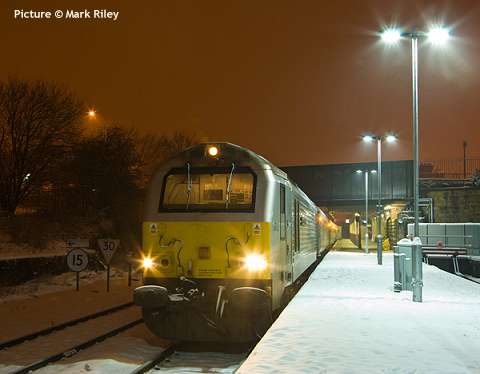
67 013 Dyfrbont Pontcysyllte awaits
departure from Wrexham General platform 1 with the 1P13 07:23 service
to Marylebone on
12 January, with DVT 82305 at the rear. Picture by Mark Riley.
This site is dedicated to all our regular contributors and
supporters, and especially the rail staff of North Wales.
24 January 2010

The snows of 2010 - report by Mark Riley
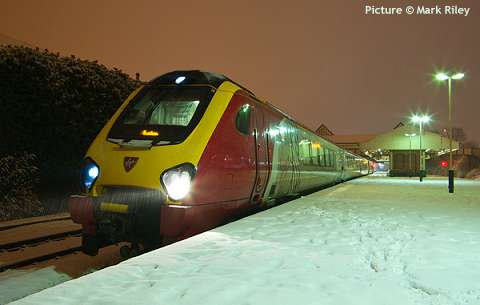
12 January saw yet more snow hit North Wales, as everywhere else. By
the time I took this picture at Wrexham General, it had already been
snowing since 02:00. 220 017 Bombardier Voyager
awaits departure with the 07:00 service to London Euston. Thanks to the
friendly driver who offered to turn the headlights off (looks better on
as it shows the snow falling!) and turned the cab light on. Only a
handful of passengers got on at Wrexham.
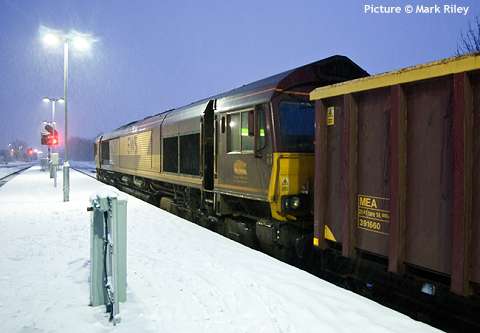
I knew that the Penyffordd coal train was running, so I opted to take a
picture where there was most light at platform 1. Fortunately 66 207
paused for a couple of minutes before running up to Croes Newydd, so I
was able to fire off a couple of quick pictures. The train consisted of
approximately 24 MEA wagons, shorter in length than used to be seen.
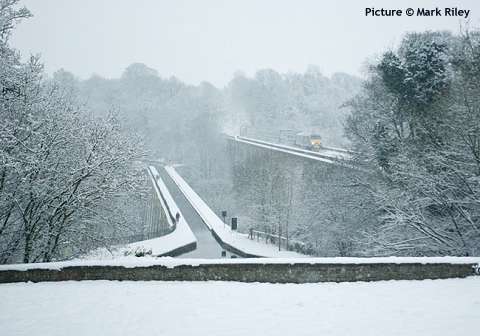
I managed to reach Chirk as the main A483 road was safe and clear
though very quiet as many people were stranded in outlying villages and
estates. The photo shows (just!) DVT 82304 crossing Chirk Viaduct
through the snow in bound with 1J82 11:20 from Marylebone.
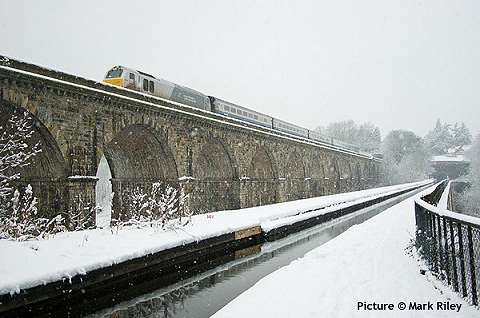
I walked across the aqueduct to photograph the train returning as 1P33
15:23 to Marylebone. No canal boats, no ducks and very few people. I
watched several pieces of ice drifting along, though none were around
when the picture was taken which was a shame. 67 013 is seen powering
over the viaduct shortly after leaving Chirk station. The snow finally
fizzled out at 22:00.
Llangollen Pannier
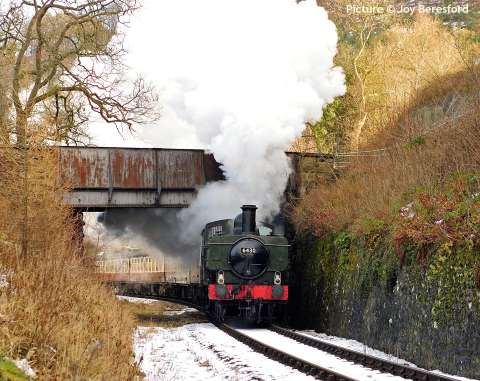
The Llangollen railway Sunday steam services recommenced on 17 January:
there was still a little snow and ice left in a few spots. Duty loco
was pannier tank 6430 seen
above 'Climbing Away' from Llangollen (Joy
Beresford)

'Light and Shade at Berwyn (John
Beresford)
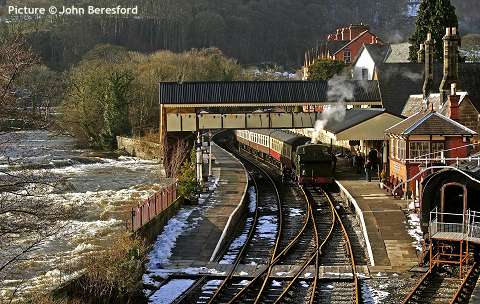
'Resting by the Riverside' at Llangollen (John Beresford)
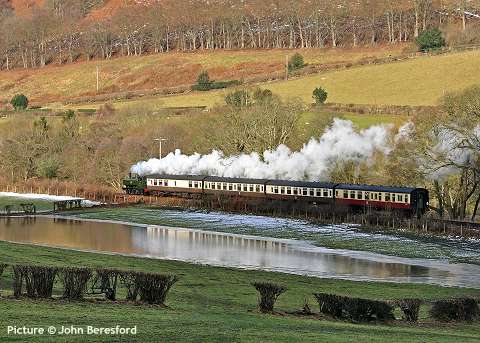
'Through Frozen Fields' (John Beresford)
The fatal accident at Moreton-on-Lugg: aftermath
Further to our item in the last issue, The
Rail Accident Investigation Branch has now issued its preliminary
report, which says:
The RAIB’s preliminary examination
indicates that the level crossing barriers were raised as the train was
approaching the crossing. There is no evidence that the actions of the
motorists or the driving of the train contributed to the accident.
The British Transport Police appear to be carrying out their own
investigation. Network Rail has also provisionally admitted
responsibility:
We consider that the accident is most
likely to have been due in some way to Network Rail. Network Rail has
extended a full and complete apology to the family. We would also like
to extend this apology to everyone who has been so deeply affected by
the accident and to the community of Moreton-on-Lugg.
The train involved, 175 103, stood up well to the impact, staying on
the line and protecting the crew and passengers well despite the car
being dragged for some distance and scraped along the off-side of the
leading vehicle, 79753, damaging some of its underfloor equipment but
fortunately not breaching the fuel tank. The cab windows were not
broken, although the fibreglass fairing, which is purely for
air-smoothing and aesthetic reasons, was shattered. It will certainly
be out of traffic for a while.
Two mornings at Gobowen - with Andrew Vinten

I spent the late morning of Thursday 21 and Friday 22 January at
Gobowen in the hope of catching either Dee Marsh - Margam freight
train 6V75 or any of the Wrexham & Shropshire services. On
Thursday, 66 166 was hauling
6V75 and my shot (above) shows it heading through Gobowen station.

A short time later DVT 82301 appeared, at the head of 1J80 07:33
London Marylebone - Wrexham. ...

... which was being propelled by 67
012 A Shropshire Lad.

On my way home on 22 January I received information that 6V75 had left
Dee Marsh over an hour late; as I was near Gobowen I made my way to the
station, where after a short wait 67
013 Dyfrbont Pontcysyllte
arrived hauling 1P13 11:27 Wrexham - London Marylebone.

The nameplate - a challenge for the English speaker. DVT 82305 was on
the rear.

At about 12:30, 6V75 emerged from the gloom with 66 114 at its head, powering up the
gradient towards Shrewsbury.
Wagon digression - by Charlie Hulme

Andrew Vinten also took this
picture of the various wagon types in 6V75, here's a brief spotter's
guide. The wagons used in these trains are mainly from various batches
of 'telescopic' wagons designed to carry rolls of steel sheet, made in
South Wales, which need
protection from the elements while on their way to Shotton where a
protective coating is applied. By sliding the telescopic parts of the
body, the rolls can be loaded from above by crane.
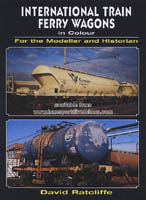 The most common type,
including and the ones nearest the camera in the picture (code JSA, or
KIA if internationally registered) The ones with ribbed sides are the
original style, clearly showing a resemblance to the common type of
ferry van. The ones with plainer sides have been converted from
redundant tippler wagons originally used to carry imported iron ore.
Also seen are some French-built internationally-registered wagons (code
IHA) which use canvas or similar material to protect the load, and the
code BYA wagons with telescopic covers to a curved profile which were
built for EWS in 1998-9 by the short-lived Thrall wagon works in York.
Follow this link to
www.ltsv.com for a very
interesting website with lots of information.
The most common type,
including and the ones nearest the camera in the picture (code JSA, or
KIA if internationally registered) The ones with ribbed sides are the
original style, clearly showing a resemblance to the common type of
ferry van. The ones with plainer sides have been converted from
redundant tippler wagons originally used to carry imported iron ore.
Also seen are some French-built internationally-registered wagons (code
IHA) which use canvas or similar material to protect the load, and the
code BYA wagons with telescopic covers to a curved profile which were
built for EWS in 1998-9 by the short-lived Thrall wagon works in York.
Follow this link to
www.ltsv.com for a very
interesting website with lots of information.
While on the subject of wagons, a very interesting recent book International Train-ferry Wagons in Colour,
by
David
Ratcliffe
(Ian
Allan, 2009) tells the fascinating story of the
Dunkirk and Zeebrugge train ferries and the wagons used on them until
the Channel Tunnel replaced them (not altogether satisfactorily) in
1995. The international steel-carriers are includes as well as various
other types which have appears in North Wales from time to time,
including the chemical tankers which ran to Amlwch. It can be bought
on-line from the Transport
Diversions
Emporium.

As a reminder of those train-ferry and Speedlink days, I can't resist
including one of my own pictures from 1990 showing the afternoon
Trafford Park - Warrington train at Stockport, hauled by one of Tinsley
depot's unofficially-named Class 47s. The first wagon is a Cargowaggon
van in the original livery. I would often wait for this train most days
on my way home from work - its consist was usually short, fascinatingly
varied, and very modellable, ferry vans and Cerestar starch tanks were
most common.
Ffestiniog runs sherry and mince pie trains
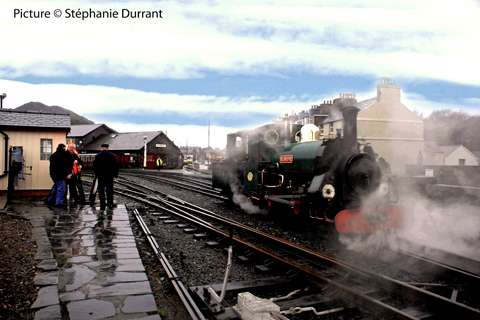
'Sherry and
Mince Pie' trains are running every Wednesday, Thursday, Saturday and
Sunday until Thursday 11 February (inclusive). Trains depart Porthmadog
13:15 and run to the viewing point at Trwyn-y-Garnedd and back,
arriving Porthmadog 14:30. Fare is a very reasonable £8.50 Adults
(including sherry &
mince pie or a cuppa and a biscuit), and £1.80 for
accompanied children: phone 01766 516024 before travelling to check
details and availability.
Picture above by Stéphanie
Durrant: Blanche in
action in the rain at Porthmadog , 20 January.
The snows of '82 - report by Aled Rees

The recent snows have prompted me to dig out my old photos of Cemmaes
Road on the Cambrian, where I lived as a child. A visit to
the signal box following the January 1982 snows resulted in these views
of the two signalmen digging out the level crossing ...

... and a class 25 that had just arrived from Talerddig on snow
clearing duties. I recall the driver commenting that he had come
through 20-foot drifts. The engine duly returned up the line for a
second clearance and the line was closed for a few days.
8 January 1982 was a dramatic day on the Cambrian Coast line, when two
trains became trapped in the snow. One coach of an empty DMU became
derailed near Tal-y-Bont; the crew managed to uncouple the derailed
driving trailer vehicle and escape to Porthmadog in the remaining power
car. The 12:10 Pwllheli - Dovey Junction service train, again a DMU,
became trapped in a snowdrift near Tonfanau, with the driver, guard,
four passengers and a railway maintenance worker aboard. Luckily, the
train heaters were working. According to a Railway Magazine report:
The driver and guard struggled through
90 mph gusts of wind and falling snow to a lineside telephone four
times between 14:30 and 21:00 to try and find out what was happening. 25 201 was sent from Machynlleth to
assist, but this could not get through snowdrifts near Tywyn. Another
Class 25, fitted with miniature snowploughs, was sent from Shrewsbury,
but was delayed by snowdrifts and frozen points. A helicopter from RAF
Valley tried to reach the train, but was unable to do so, and
eventually, after spending the night in the train, the passengers and
railwaymen were taken off by the helicopter which managed to land
nearby at about 10:30 next morning and given breakfast at a local guest
house.
25 201 managed to collect its stranded sister loco and the DMU at
Tonfanau on 10 January, but became derailed itself while trying to
reach Tal-y-Bont, and yet another loco was sent, only to become stuck
itself. The line did not reopen to traffic until 18 January.
Conwy Valley views - by Darren and Stephanie Durrant
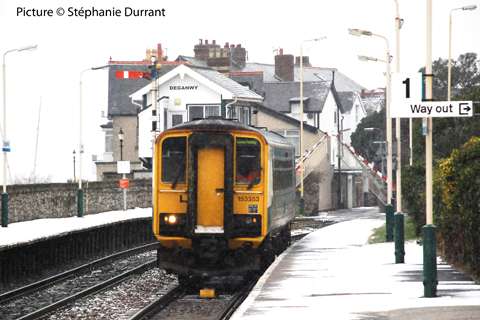
153 353 calls at Deganwy, 12
January. A case for one of the new 'platform humps'? (Stéphanie Durrant)
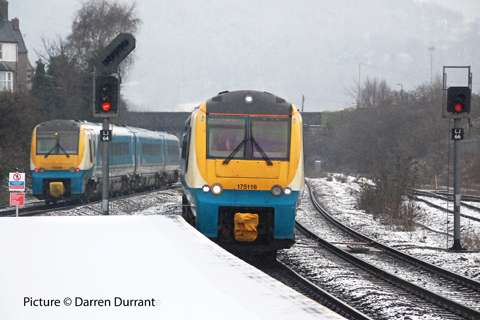
Protective coupler bags are the order of the day as 175 104 meets 175 116 (right) at snowy Llandudno
Junction on 14 January (Darren Durrant)

High tide as 153 327 runs in
to Glan Conwy, 15 January (Stéphanie
Durrant)
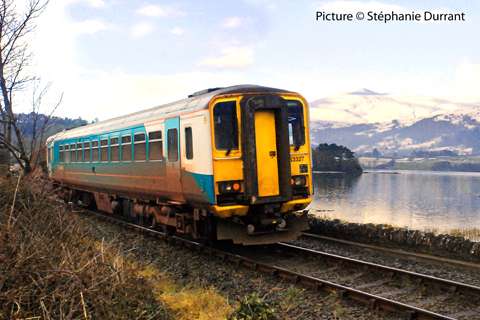
Heading for the hills (Stéphanie
Durrant)
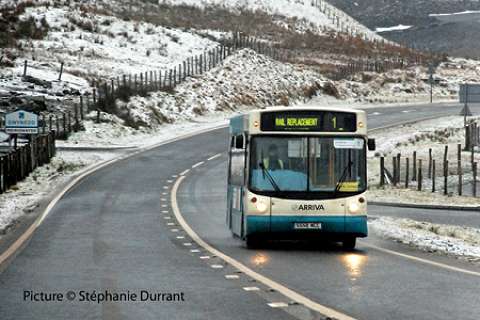
The Conwy Valley line is closed for engineering work between North
Llanrwst until 31 January: above, an Arriva Rail Replacement bus
climbs out of Blaenau Ffestiniog, crossing the Gwynedd county border,
on 20 January. (Stéphanie
Durrant)
RCTS news - by Richard Neale
The Railway Correspondence and Travel Society (RCTS) meeting takes
place on Monday 1 February at 7.45 p.m. at the Lever Club, next to Port
Sunlight railway station. The evening will see a presentation
entitled 'Terminus' by Prenton-based member, Mr Barry Shore. He
will be showing a second selection of slides taken over a period of the
past 40 years and more of passenger trains completing their journeys at
stations in the south and west of England.
Visitors will be made most welcome after making a £2 donation at
the entrance to the meeting. Such donations contribute a great
deal to the well-being of the local branch.
Freightliner views
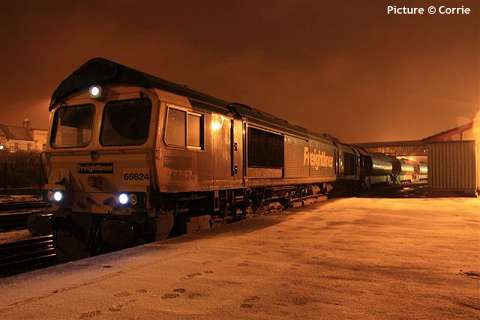
Early in the morning of 18 January, 66
624 waits at Holyhead with an empty ballast train following
weekend engineering work. Picture by Corrie.
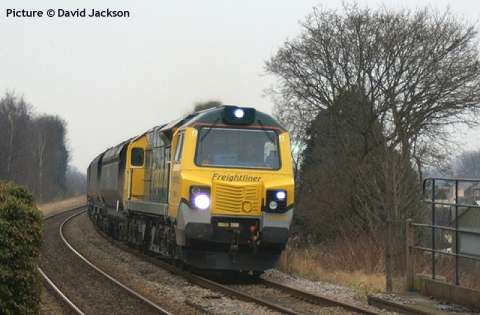
Class 70: Ugly, or maybe 'growing on you'? 70 006 heads through Frodsham
on 20 January with train 6F02, another load of coal from Ellesmere Port
to Fiddlers Ferry (David Jackson).
Off yer bike
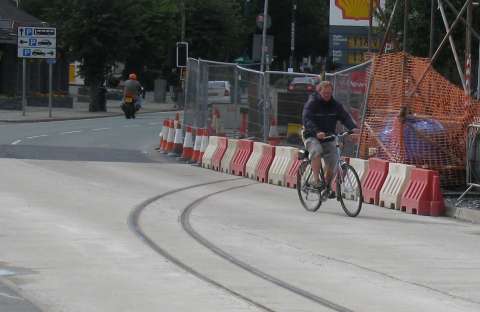
The controversy about alleged danger to cyclists caused by the rails in
the road where the Welsh Highland line takes to the street in
Porthmadog has reared its head again, thanks to the Daily Post
newspaper which saw fit to make a Freedom of Information Act for a
letter written some time ago by Chief Superintendent Geraint Anwyl,
Western divisional commander, North Wales Police, prompted by then
Chief Constable Richard Brunstrom:
There have been a number of collisions
where cyclists have been thrown from their bikes as a result of wheels
dropping into the railway line. The risk to road users at this location
is wholly unacceptable and I would most strongly urge you to implement
an engineering solution in order to alleviate the problem. The Welsh
Highland Railway has a duty of care to road users and although
collisions are already occurring there is no evidence of intervention
at strategic level. If a fatal collision occurs at this location
involving a pedal cyclist I will, as Commanding Officer, initiate a
robust investigation into Corporate Manslaughter.
Our pictures here were taken during the construction of the new line in
2008. Above is the line as it enters the street from the Caernarfon
direction, at a reasonably obtuse angle to the street, which should not
be too much of a problem: the cyclist in the picture seems to have
negotiated it without trouble.
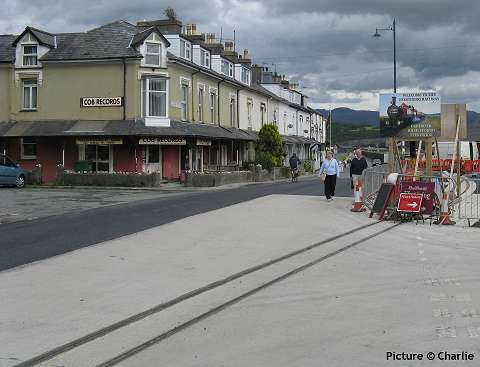
At the other end of the bridge, however, one can see how a cyclist
approaching from across the Cob might encounter difficulty. The
official response from the WHR management reads:
As part of its project to rebuild the
Welsh Highland Railway from Caernarfon to Porthmadog, the Ffestiniog
Railway was granted rights under a Transport and Works Act to construct
the basic railway at this location. The tracks across Britannia Bridge
have been in place since June 2008, together with bilingual signs
warning road users of railway tracks in the road and advising cyclists
to dismount and walk across.
Over the last four months, informal consultation meetings have been
held with the Office of the Rail Regulator and statutory bodies ahead
of the formal application for a crossing order which will be submitted
during January 2010. Once this order is granted the work will be
completed on the crossing including the road markings and installation
of traffic signals. The crossing will then be brought into use. Regular
public train services across the bridge will not start until the spring
of 2011. ... Around six train movements are expected on a normal day.
Each takes less than two minutes and train speed will be limited to
five mph as a primary safety measure.
Until the crossing design is finalised and approved the company has
covered the rails with tarmac enabling traffic to flow in exactly the
same way it did prior to the installation of the track. The completed
crossing will make full provision for pedestrians, cyclists and road
traffic to interact safely with railway traffic. Cyclists will be
diverted via a clearly marked route which takes them safely over the
rails.
The company understands that there is also a plan to extend the
existing cycle track across the Cob embankment around the back of the
Inland Revenue offices and thence to Llyn Bach, avoiding the Britannia
Bridge completely.
When essential engineering train movements are required prior to the
completion of the crossing, traffic management is put in place whilst
the tarmac is removed and the train worked across the bridge. The
tarmac is then replaced immediately afterwards.
The more recent view below, looking towards Caernarfon shows the
current, rather awkward, but surely not unsafe, solution.
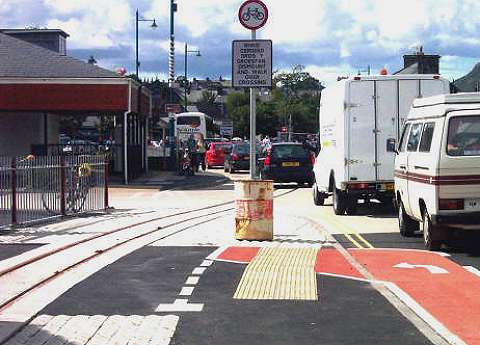
This road is part of National Cycle Route 8, so is often busy with
cyclists: clearly a totally separate route would be be the best
solution in many ways: Porthmadog High Street is very busy. But this is
not the only place where cyclists have to be careful crossing railway
lines: the level crossing on the Cambrian Coast line at Harlech, for
example, is very acute, and we hear nothing from the Chief Constable
about that one.
To
the
North
Wales
Coast
home
page : 2010
Archive
: To
the previous Noticeboard


















 The most common type,
including and the ones nearest the camera in the picture (code JSA, or
KIA if internationally registered) The ones with ribbed sides are the
original style, clearly showing a resemblance to the common type of
ferry van. The ones with plainer sides have been converted from
redundant tippler wagons originally used to carry imported iron ore.
Also seen are some French-built internationally-registered wagons (code
IHA) which use canvas or similar material to protect the load, and the
code BYA wagons with telescopic covers to a curved profile which were
built for EWS in 1998-9 by the short-lived Thrall wagon works in York.
Follow this link to
www.ltsv.com for a very
interesting website with lots of information.
The most common type,
including and the ones nearest the camera in the picture (code JSA, or
KIA if internationally registered) The ones with ribbed sides are the
original style, clearly showing a resemblance to the common type of
ferry van. The ones with plainer sides have been converted from
redundant tippler wagons originally used to carry imported iron ore.
Also seen are some French-built internationally-registered wagons (code
IHA) which use canvas or similar material to protect the load, and the
code BYA wagons with telescopic covers to a curved profile which were
built for EWS in 1998-9 by the short-lived Thrall wagon works in York.
Follow this link to
www.ltsv.com for a very
interesting website with lots of information.












